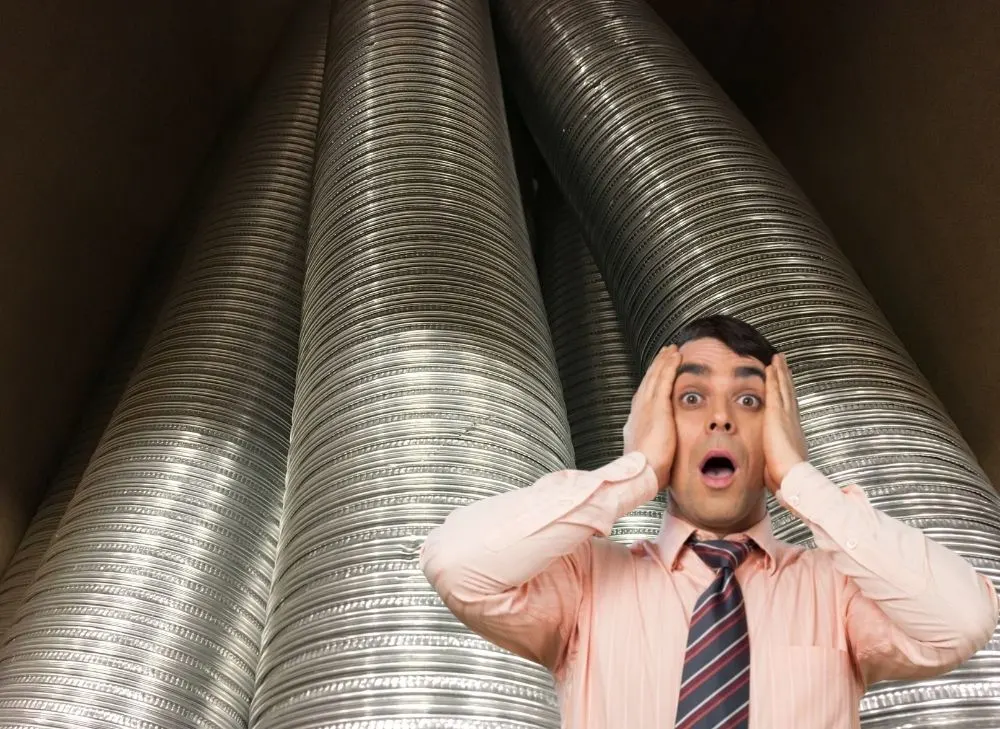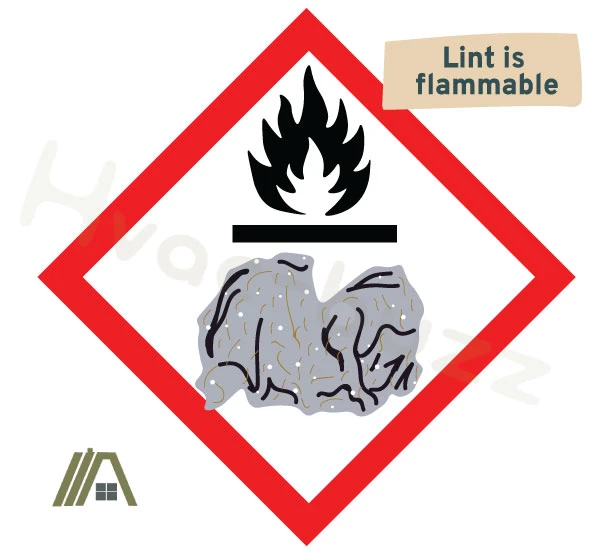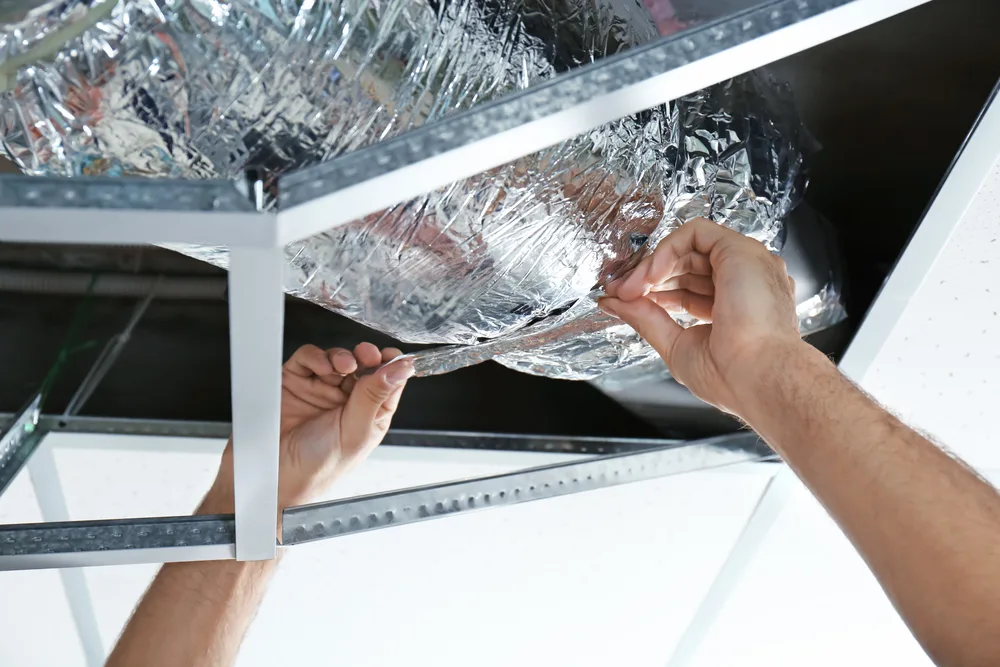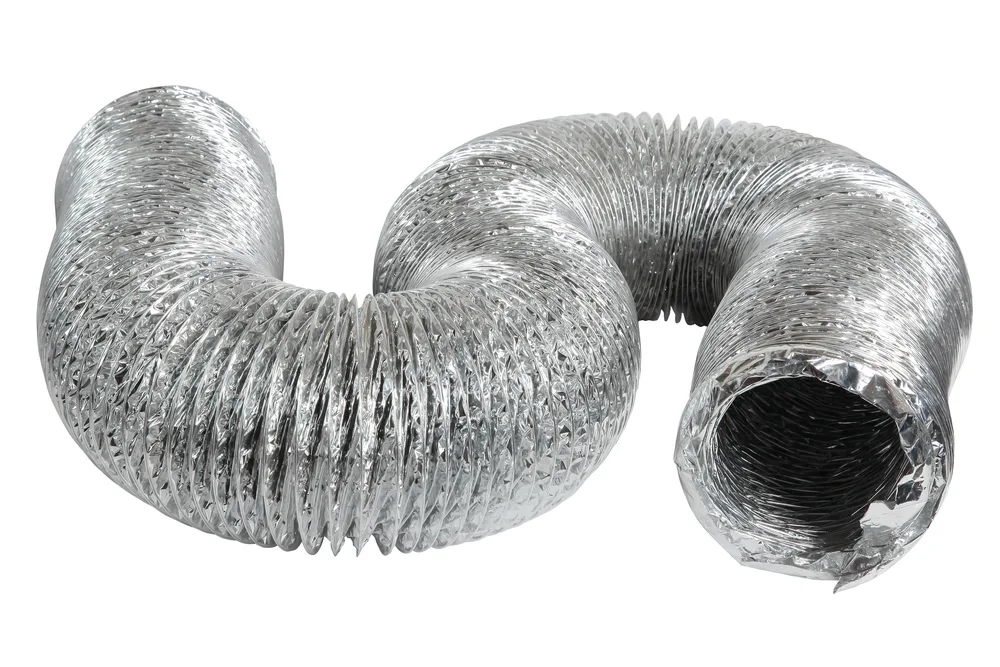Foil dryer ducts are praised for their maneuverability as well as their light weight, but they are certainly not without their limitations, some of which have serious safety implications, especially in dryers. With dryer fires being one of the top causes of home fires, it is important to reduce the risk of dryer fires by any means possible.
Below, I will go over whether or not foil dryer ducts are compliant with the International Residential Code (IRC), various fire safety problems with foil dryer ducts, as well as alternative options for foil ducts.

Foil dryer ducts aren’t safe. The flexibility and ridges lead to lint accumulation and greater difficulty cleaning the lint out. As lint builds up, a serious fire risk develops. It also makes the dryer motor strain to exhaust air. It overheats and adds to the potential for fire. Foil ducts contravene the IRC.
Foil Dryer Ducts Are Not Compliant With the IRC
Although foil dryer ducts can be more lightweight and easier to install than rigid dryer ducts, their lack of rigidity makes it so that they are not compliant with the IRC.

According to Section M1502.4.1 of the IRC:
“Exhaust ducts shall have a smooth interior finish and shall be constructed of metal not less than 0.0157 inch (0.3950mm) in thickness (No. 28 gauge).”
The smooth interior finish means that foil dryer ducts do not comply with the regulations of the IRC.
Aluminum foil bends and forms ridges naturally, making its interior finish far from smooth. Foil is technically made of metal, but not the rigid metal that the IRC requires for dryer vents.
Another aspect of foil dryer ducts that excludes them from complying with the IRC is the thickness of the foil ducting. As said above, the metal must be at least 0.0157″ thick.
Although some foil ducts may comply with this, it is likely that they won’t, since they are often significantly thinner than standard metal ducts.
These specifications of the IRC may seem strange, but it is important to note that the IRC’s rules are made to ensure that structural integrity, as well as human safety, is maintained.
Foil dryer ducts have a tendency to droop in addition to the formation of ridges inside of the ducts. This leads to lint getting caught and accumulating, which can be very dangerous because of how flammable lint is.
Foil Dryer Ducts Are Not Safe
Although dryers are a convenient appliance for household chores, their function comes with very real danger.
Moist air and lint are exhausted out of the dryer, and this moisture weighs down the lint, causing it to become stuck and accumulate. This accumulation of lint can also lead to your backdraft damper flaps being stuck open and cold air rushing into your house.
Since lint is flammable, its accumulation with the added heat from dryer exhaust makes fires a very real possibility, especially since blockage of the dryer vent can cause overheating.
Lint is Flammable
Emptying a dryer right after its cycle is done often means your clothing will be cozily warm, which makes doing laundry a lot more pleasant. If your dryer is in the master closet, you can even pull the clothes on while they are still warm.

However, the dryer itself and its exhaust produce much more extreme heat, which is not comfortable in the slightest.
Exhaust from your dryer is often between 120 and 160 °F. Accumulated lint, which often consists of cotton and perhaps wool fibers, ignites at a temperature of about 250 °F.
Although the exhaust may not reach these temperatures normally, if your dryer is broken and producing much more heat than a functioning one would, temperatures may rise enough for the lint in your vents to ignite.
Moreover, as lint builds up, it makes the dryer fan motor strain harder to exhaust the air, causing the fan to overheat, which increases the temperature of the exhausted air. So, the very fact that the ducts are filled with lots of flammable lint may be enough for the dangerous temperatures to be reached.
A more constant danger is the temperature of the heating element that is inside the dryer cavity. Not only does lint accumulate in the vents, but it can also accumulate in the dryer cavity, particularly if there is a backup from the vents themselves.
Since the heating element can get up to 550 °F, the lint would be well above its igniting temperature, and a fire would be imminent.
Ridges in Foil Duct Are Lint Traps
The dryer vents are responsible for both expelling waste air and the lint that comes along with it. The ridges and folds that tend to form in foil ducts are bound to trap lint, which often leads to fires.
Unlike rigid metal ducts, whose inner surfaces are smooth, foil ducts have many ridges for lint to get stuck on.
A factor that makes this worse is the fact that air coming from these vents is often saturated with water vapor since the water carried by the wet clothing must go somewhere.
Humid air would then introduce water to the lint, which weighs it down. This makes it harder for the lint to be expelled from the ducts and makes it more likely for the lint to get caught on one of the ridges.
As more and more lint is caught on the ridges, they create barriers over time. Still more lint is caught and accumulates, which is definitely a safety risk.
Harder to Clean When Ducting Isn’t Smooth
It may seem like a somewhat easy fix to the accumulation of lint in your dryer vents would just be to clean the vents more often. This is not necessarily true, though, since the ridges of foil ducting don’t just lead to the accumulation of lint, they also make the vents much harder to clean.
A vent cleaning kit from the store often comes with a circular brush made for detaching lint and a rod that can extend into your dryer vent.
With the aid of a vacuum hose or shop vac, these tools should clean your vents fairly thoroughly, but in foil dryer ducts, the process becomes less thorough.
Not only do the ridges of foil ducts trap lint, but they also make it harder to remove. This means that a cleaning session for foil ducts would not have the same results as in smooth ducts.
It is likely that the ducts will still contain lint that is difficult to remove, leading to more lint accumulating in these uncleaned areas. This makes fires more likely in your home.
Foil Ducting Is Prone to Sagging
Not only can lint blockage occur in the crimps and ridges of foil dryer ducts, but it can also occur where the foil ducting is sagging.

Sagging occurs in foil ducting because the ducting is not rigid, so its shape doesn’t hold well.
The sagging of foil ducting is made worse by the fact that lint, as well as water, often accumulate here. The added weight of the lint and water make the sagging worse.
Accumulated water in your dryer ducting can lead to water leaks since this type of ducting isn’t made to prevent leaks of liquid water.
Water leaks lead to water damage, which is an expense that can be avoided by choosing a different kind of dryer duct.
Water damage is not the only concern with sagging ducts. Your dryer function can be impaired by water accumulation as well as blockage of airflow through the dryer ducts. This can lead to your clothes not being fully dry at the end of a cycle or other problems with your dryer function.
Breaks Are More Likely in Foil Ducts
Foil ducts are easily to break than solid metal. There are a range of issues and dangers associated with broken dryer ducts, including moisture-related structural damage, water leaking onto wires and other electrical components, mold growth, and lint fires.
Ducting Must Contain Fires
In the event of a dryer fire, it is best to have vents that can contain the fire so that it doesn’t spread through the rest of the house.
It is possible that a small fire with only a small amount of lint would be able to burn out while being contained within the ducts. As soon as the fire becomes larger with more lint to use as fuel, the integrity of the ducts becomes important.
While rigid metal ducts are fairly well-suited for containing fires, foil ducting certainly isn’t. Aluminum foil quickly disintegrates in a fire, meaning that the fire is no longer contained within the ducts.
This means that the fire, as well as its smoke, can easily spread through your home.
Although rigid metal ducts cannot contain a very large fire for very long, they can certainly give you more time to evacuate your home and call emergency services. The fire is contained for a longer period of time and smoke would slowly enter the home, indicating that a dryer fire is occurring.
For foil ducts, though, a large enough fire would quickly disintegrate the ducts, making the fire spread faster. This means less warning time and more imminent danger.
Better and Best Dryer Duct Materials
The material, texture, and rigidity of foil dryer ducts are what make them a fire hazard as well as a liability for your dryer.

A better duct choice would be a semi-rigid metal dryer duct. This would comply with the IRC-mandated thickness and would also be more rigid than foil.
A semi-rigid metal dryer duct withstands fire better than a foil duct and also has smaller and fewer ridges for lint to get caught on. It also is less likely to sag and therefore is less likely to have lint and water buildups.
I recommend the Builder’s Best Single Elbow Dryer Vent Duct Kit (amazon link) for its high ratings, and high-temperature range (able to withstand temperatures of up to 430 °F).
The best option, though, would be a fully rigid metal dryer duct, such as one made of galvanized sheet metal. This product has smooth, straight walls to almost fully eliminate the possibility of lint trapping. This smooth design also provides for high-velocity airflow.
Not only will this product withstand fire better than a foil duct would, but its rigid design will prevent sagging even more than a semi-rigid duct could.
Both the resistance to sagging as well as the smooth inside of these vents makes lint and water buildup a small possibility, which will protect your home from dryer fires as well as water damage.
I recommend the DUNDAS JAFINE Heavy Gauge Dryer Vent Pipe (amazon link) for its durability and ease of installation.
Sources
https://homex.com/ask/how-hot-does-dryer-vent-get
https://bungalow.com/articles/how-to-clean-your-dryer-vent-and-why-you-need-to-in-the-first-place
